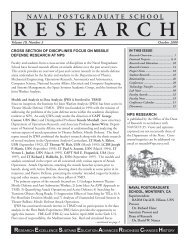Spectral Unmixing Applied to Desert Soils for the - Naval ...
Spectral Unmixing Applied to Desert Soils for the - Naval ...
Spectral Unmixing Applied to Desert Soils for the - Naval ...
Create successful ePaper yourself
Turn your PDF publications into a flip-book with our unique Google optimized e-Paper software.
iochemical components of plants <strong>to</strong> absorption feature depths in plant material (Curran<br />
et al., 2001; Kokaly and Clark, 1999; Mutanga et al., 2004; Noomen et al., 2006). Weber<br />
et al. (2008) and O’Neill (1994) were able <strong>to</strong> use <strong>the</strong> continuum removal method <strong>to</strong><br />
discriminate biological crustal components of soils known as cryp<strong>to</strong>biotic crusts from<br />
bare soils and Clark and Roush (1984) as well as Kruse (1988) discuss <strong>the</strong> usefulness of<br />
continuum removal in mineral mixture analysis.<br />
D. RELEVANT MILITARY AND CIVILIAN APPLICATIONS OF IMAGING<br />
SPECTROSCOPY<br />
Imaging spectroscopy has been used by <strong>the</strong> military <strong>for</strong> a number of purposes.<br />
One instance is in determining terrain trafficability (<strong>the</strong> capability of an area <strong>to</strong> bear<br />
traffic and permit continued movement of that traffic) by first identifying and <strong>the</strong>n<br />
mapping surface compositions of an area (Kruse et al., 2000). While <strong>the</strong> hyperspectral<br />
data alone were not sufficient due <strong>to</strong> a lack of in<strong>for</strong>mation on terrain such as slope or<br />
surface texture; when used in conjunction with digital elevation models (DEMs),<br />
syn<strong>the</strong>tic aperture radar (SAR), or o<strong>the</strong>r datasets, hyperspectral imagery can be very<br />
useful (Kruse et al., 2000). The in<strong>for</strong>mation that was provided by hyperspectral data in<br />
this study included composition and distribution of soils, vegetation, manmade materials,<br />
and drainage features (Kruse et al., 2000). Kruse et al. (2000) were <strong>the</strong>n able <strong>to</strong> use this<br />
in<strong>for</strong>mation <strong>to</strong> produce a trafficability product providing <strong>the</strong> consumer with in<strong>for</strong>mation<br />
that is helpful in navigating through areas of potential risk; such as steep slopes with a<br />
principal constituent of clay that could potentially hinder movement (Kruse et al., 2000).<br />
A second example where hyperspectral imagery has been of use <strong>to</strong> <strong>the</strong> military is in <strong>the</strong><br />
exploration of target and anomaly detection (Manolakis et al., 2003). Because<br />
hyperspectral imagery relies on data collected over a contiguous spectrum, unlike some<br />
traditionally used passive imaging systems, it can identify objects that are partially<br />
hidden from view and identify <strong>the</strong>m by <strong>the</strong>ir spectral characteristics instead (Manolakis et<br />
al., 2003).<br />
A study by Collins et al. (1997) provides an example of spectral characteristics<br />
being utilized <strong>to</strong> identify anomalies using SEBASS data in <strong>the</strong> long wave infrared regions<br />
(LWIR). Through <strong>the</strong> use of Hyperspectral imagery and principal component analysis,<br />
12
















